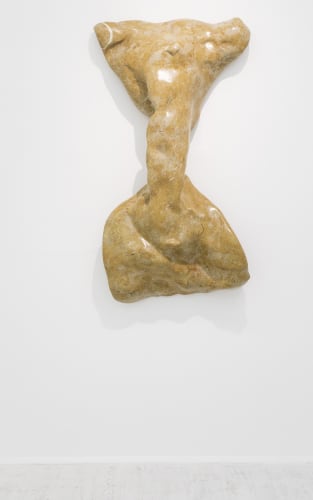“Benglis and the Baroque,” Lynda Benglis’s first solo show in Italy, highlights the artist’s long-standing interest in the period in question. The sinuousness of seventeenth-century sculpture, along with the Baroque enthusiasm for artifice, is reflected in the American artist’s magmatic forms. In this exhibition, she continues to address themes of the knot and the torso, interpreting the topos of the male bust without limbs. As such, in Torso, 2016, a piece comprising five torsos created for this show, Benglis reprises the sculpture of Gian Lorenzo Bernini. Here, for the first time, Benglis has exploited the pictorial properties of five different types of marble—Marquina black, Carrara white, Giallo Reale yellow, Rosso Francia red, and Guatemala green—each forming the material of a single figure. Her choice of polychrome marble refers less to its use in a decorative tradition enduring from antiquity to the Baroque era than to Bernini’s treatment of the material as a means toward theatrical, symbolic, and structural ends. Looking at the spiraling twists of Bernini’s statues, Benglis freezes the body’s energy in the lucid beauty of the marble. The corporeal becomes abstract while remaining organic and alive; the stone, in turn, comes alive. In the red sculpture, for example, it becomes pulsating flesh, traversed by veins. In the white piece, the marble seemingly reaches toward a state of purity, suggesting movement and capturing light. Benglis exploits the characteristics of the different marbles: Inscribed on the torso’s surfaces are lattices of signs that follow the shapes’ convexities and concavities, unequivocally giving them a heightened physical presence.
Dicembre 10, 2016
285
di 417


